Handsome, suave English-American actor Cary Grant (1904-1986) became one of Hollywood's definitive classic leading men, known for his debonair demeanour. Grant’s best-known films include Bringing Up Baby (1938), The Philadelphia Story (1940), His Girl Friday (1940), Notorious (1946), An Affair to Remember (1957), North by Northwest (1959), and Charade (1963).

Belgian postcard by N.V. Victoria, Brussels, no. 639. Photo: Metro-Goldwyn-Mayer.

French postcard by EPC, no. 29. Photo: RKO.

British postcard in the Colourgraph Series, London, no. C 213. Photo: Paramount.

British postcard in the Picturegoer Series, London, no. 735A. Photo: Paramount.
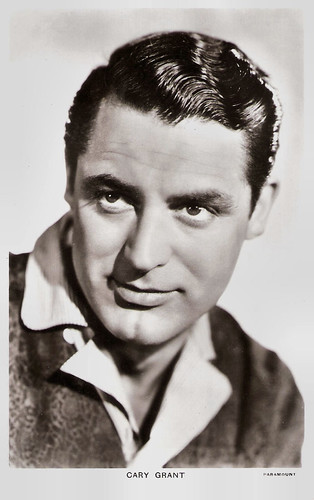
British postcard in the Picturegoer Series, London, no. 735b. Photo: Paramount.

British postcard in the Picturegoer Series, London, no. 735c. Photo: Columbia.

German collectors card. Photo: RKO Radio Film. Cary Grant and Ingrid Bergman in Notorious (Alfred Hitchcock, 1946).

British postcard in the Picturegoer Series, London, no. W 609. Photo: R.K.O. Radio.

American postcard by Fotofolio. Photo: Milton H. Greene. Caption: Cary Grant, New York City, 1958.
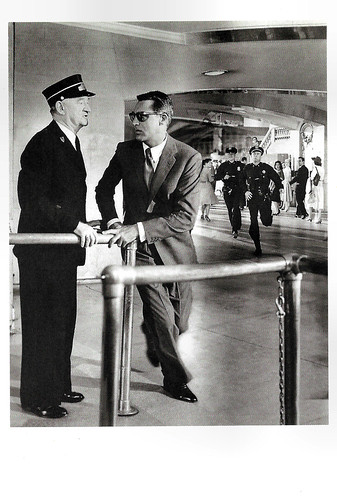
French postcard in the Collection Noire by Editions Hazan, Paris, no. 6492, 1996. Photo: Collection Dominque Lebrun D.R. Cary Grant in North by Northwest (Alfred Hitchcock, 1959).
Cary Grant was born Archibald Alexander Leach in Horfield, Bristol, England, in 1904. His parents were Elsie Maria (Kingdon) and Elias James Leach, who worked in a factory. Grant considered himself to have been partly Jewish. He had an unhappy upbringing in Bristol. At age nine, he came home from school one day and was told his mother had gone off to a seaside resort. The real truth, however, was that she had been placed in a mental institution, where she would remain for years, and he was never told about it. Grant did not learn that his mother was still alive until he was 31, when his father confessed to the lie, shortly before his own death.
At age 14, Archibald dropped out of school. He lied about his age and forged his father's signature on a letter to join Bob Pender's troupe of knockabout comedians. He learned pantomime as well as acrobatics as he toured with the Pender troupe in the English provinces. Then in 1920, he was one of the eight Pender boys selected to go to the US. Their show on Broadway, 'Good Times', ran for 456 performances at the New York Hippodrome, the largest theatre in the world at the time with a capacity of 5,697. It gave Grant time to acclimatise.
Cary Grant would stay in America. He spent the next couple of years touring the United States with The Walking Stanleys. He visited Los Angeles for the first time in 1924, which left a lasting impression on him. After the group split up, he returned to New York, where he began living and performing at the National Vaudeville Artists Club. In 1927, he was cast as an Australian in Reggie Hammerstein's musical, 'Golden Dawn'.
In the following years, he gained a reputation as a romantic leading man. After a successful screen test, Paramount producer Bud Schulberg signed a contract with the 27-year-old Grant in 1931 for five years. He made his feature film debut with the comedy This is the Night (Frank Tuttle, 1932), playing an Olympic javelin thrower opposite Thelma Todd and Lily Damita.
Grant played a wealthy playboy opposite Marlene Dietrich in Blonde Venus (1932), directed by Josef von Sternberg. Mae West wanted Grant for She Done Him Wrong (Lowell Sherman, 1933) because she saw his combination of virility, sexuality and the aura and bearing of a gentleman. The film was a box office hit, earning more than $2 million in the United States. For their next pairing, I'm No Angel (Wesley Ruggles, 1934), Grant's salary was increased from $450 to $750 a week. The film was even more successful than She Done Him Wrong and saved Paramount from bankruptcy.

British Real Photo postcard. Photo: Paramount Pictures.
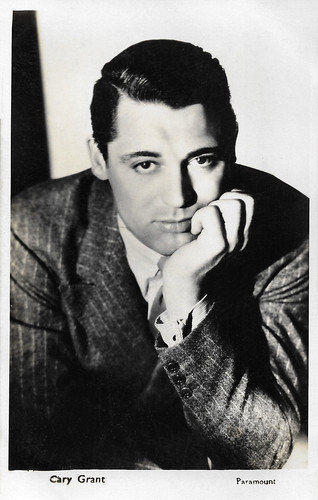
British Real Photograph postcard. Photo: Paramount.
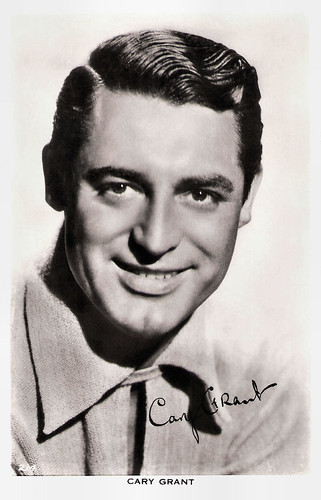
British Real Photograph postcard, no. 214.
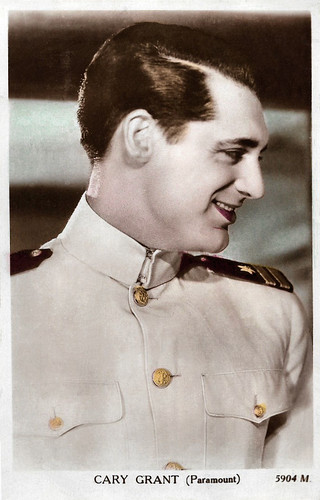
British Art Photo postcard, no. 5904 M. Photo: Paramount. Publicity still for Devil and the Deep (Marion Gehring, 1932).
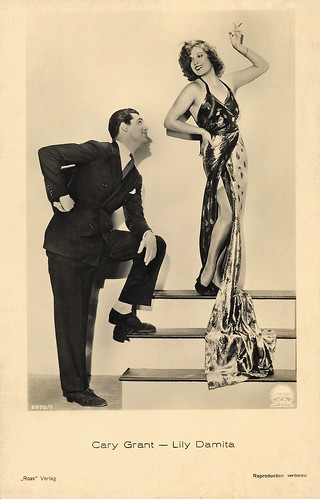
German postcard by Ross Verlag, no. 6870/1, 1931-1932. Photo: Paramount. Publicity still for This is the Night (Frank Tuttle, 1932) with Lily Damita.
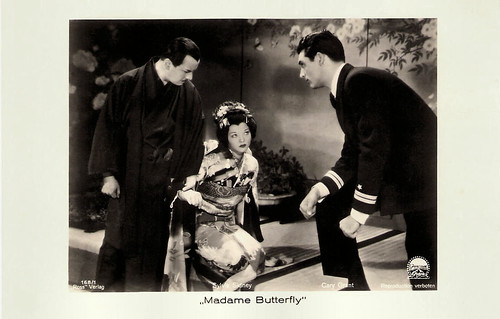
German postcard by Ross Verlag, no. 168/1. Photo: Paramount. Publicity still for Madame Butterfly (Marion Gering, 1932) with Sylvia Sidney.
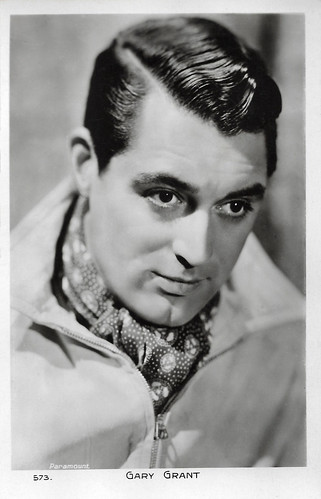
French postcard by Editions Chantal, Paris, no. 573. Photo: Paramount.
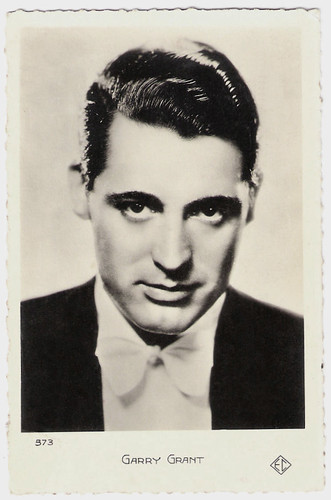
French postcard by Editions E.C., Paris, no. 373.

Belgian card by Nels for Kwatta. Photo: R.K.O.
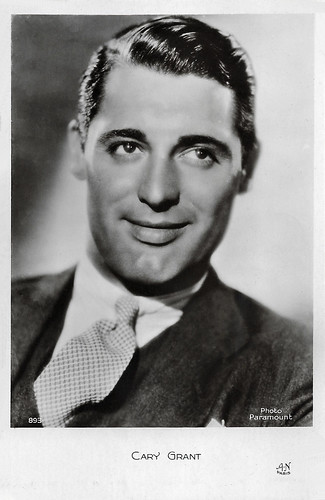
French postcard by A.N., Paris, no. 893. Photo: Paramount.
When the Paramount contract was up, Cary Grant made an unusual decision for the time: he decided to freelance. Because his films were so successful at the box office, he was able to work at any studio he chose for the majority of his career.
For Hal Roach's studio, he made the screwball comedy Topper (Norman Z. McLeod, 1937), which became his first major comedy success. The following year, he starred opposite Katharine Hepburn in the screwball comedy Bringing Up Baby (Howard Hawks, 1938), featuring a leopard and frequent bickering and verbal jousting between Grant and Hepburn.
He played a British army sergeant opposite Douglas Fairbanks, Jr. in the adventure film Gunga Din (George Stevens, 1939), set at a military station in India, and he was a pilot opposite Jean Arthur and Rita Hayworth in the drama Only Angels Have Wings (Howard Hawks, 1939). Grant gained even more success for his appearances in the romantic comedies His Girl Friday (Howard Hawks, 1940) with Rosalind Russell, and The Philadelphia Story (George Cukor, 1940) with Katharine Hepburn and James Stewart.
Along with Arsenic and Old Lace (Frank Capra, 1944) and I Was a Male War Bride (Howard Hawks, 1949); these films are among the all-time great comedy films. Having established himself as a major Hollywood star, Cary Grant was nominated twice for the Academy Award for Best Actor, for Penny Serenade (George Stevens, 1941) and None but the Lonely Heart (Clifford Odets, 1944).
In the 1940s, Grant also started a working relationship with director Alfred Hitchcock, appearing in films such as Suspicion (1941) opposite Joan Fontaine, and Notorious (1946) opposite Ingrid Bergman. Hitchcock admired Grant and considered him to have been the only actor that he had ever loved working with. In To Catch a Thief (1955), he and Grace Kelly were allowed to improvise some of the dialogue. They knew what Hitchcock wanted to do with a scene, they rehearsed it, put in some clever double entendres that got past the censors, and then the scene was filmed. His biggest box-office success was Hitchcock’s North by Northwest (1959) made with Eva Marie Saint since Kelly was by that time Princess of Monaco.
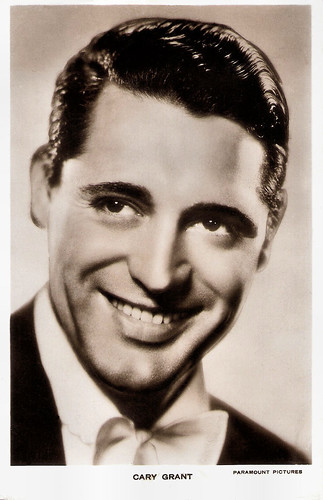
British Real Photo postcard. Photo: Paramount Pictures.

British Art Photo postcard, no. 106. Photo: Paramount Pictures Inc. Cary Grant and Joan Bennett in Wedding Present (Richard Wallace, 1936).

French postcard in the Collection 'Portraits de Cinema' (4th series, no. 2) by Editions Admira & Chapman Collection / SNAP Photos / Cosmos, no. PHN 662, 1989. Cary Grant and Katharine Hepburn in Bringing Up Baby (Howard Hawks, 1938).

British postcard in the Greetings series. Photo: United Artists. Cary Grant in Destination Tokyo (Delmer Daves, 1943).

French postcard in the Collection 'Portraits de Cinema'(2nd series, no. 9) by Editions ADMIRA & Hollywood Photographers Archives, no. PHN 357, 1987. Photo: Paramount. Caption: Cary Grant (1945).
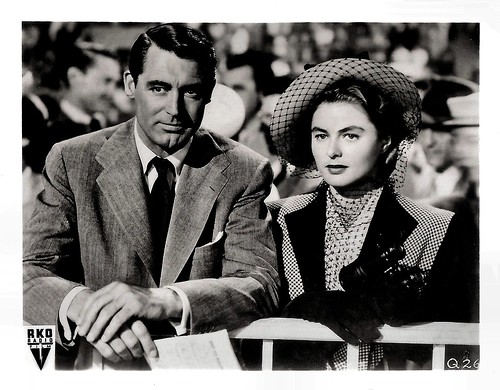
German collectors card. Photo: RKO Radio Film. Publicity still for Notorious (Alfred Hitchcock, 1946) with Ingrid Bergman.

French postcard. Photo: Keystone - L'Illustration. Cary Grant and Betsy Drake in Every Girl Should Be Married (Don Hartman, 1948).

Dutch postcard, no. 3286. Photo: 20th Century Fox. Publicity still for I Was a Male War Bride (Howard Hawks, 1949).
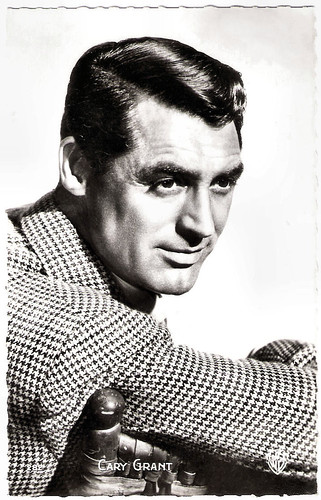
French postcard by Editions P.I., Paris, no. 287. Photo: Warner Bros.

French postcard by Editions P.I., Paris, offered by Les Carbones Korès 'Carboplane', no. 667. Photo: Paramount, 1951.
Cary Grant was young enough to begin the new career of fatherhood. Grant retired from the screen at 62, when his daughter Jennifer was born, to focus on bringing her up and to provide a sense of permanency and stability in her life. Although Grant had stopped making films, he remained active. In 1966, he accepted a position on the board of directors at Fabergé. By all accounts this position was not honorary, as some had assumed; Grant regularly attended meetings and travelled internationally to support them. The position also permitted the use of a private plane, which Grant could use to fly to see his daughter wherever her mother, Dyan Cannon, was working.
He later joined the boards of Hollywood Park, the Academy of Magical Arts (The Magic Castle, Hollywood, California), Western Airlines (acquired by Delta Air Lines in 1987), and MGM. In 1999, the American Film Institute named Grant the second greatest male star of Golden Age Hollywood cinema after Humphrey Bogart. He was nominated twice for the Academy Award for Best Actor and five times for the Golden Globe Award for Best Actor. After he retired from film in 1966, Grant was presented with an Honorary Oscar in 1970.
He expressed no interest in making a career comeback. He was in good health until almost the end of his life, when he suffered a mild stroke in October 1984. His final appearance at the Academy Awards was in 1985 to present James Stewart with an honorary Oscar for lifetime achievement. In the last few years of his life, Grant undertook tours of the United States in a one-man show, 'A Conversation with Cary Grant', in which he would show clips from his films and answer audience questions.
In 1986, Cary Grant suffered a major stroke before performing in his one-man show in Davenport, Iowa. He died later that night at St. Luke's Hospital. Grant had been married five times. His wives were actress Virginia Cherrill (1934-1935), Barbara Hutton (1942-1945), actress Betsy Drake (1949-1962), actress Dyan Cannon (1965-1968), and Barbara Harris (1981-1986).
From 1932 to 1944 he shared a house with Randolph Scott, whom he met on Hot Saturday (William A. Seiter, 1932). Studio heads threatened not to employ them together unless they lived separately. Grant's marriage to Barbara Hutton permanently dissolved his living arrangement with Scott. Grant later fell in love with Sophia Loren while filming The Pride and the Passion (Stanley Kramer, 1957) when he was 53 and she was 22. At the time, Grant was still married to actress Betsy Drake, and Loren was involved with 45-year-old producer Carlo Ponti, who was also married. Both men eventually separated from their wives and proposed to Loren at the same time. She chose Ponti.

British postcard in the Picture Show Postcard Series.

German flyer by Illustrierte film-bühne, no. 3076, part 1. Photos: Paramount. Cary Grant in To Catch A Thief (Alfred Hitchcock, 1955).

German flyer by Illustrierte film-bühne, no. 3076, part 4. Photos: Paramount. Cary Grant and Grace Kelly in To Catch A Thief (Alfred Hitchcock, 1955).
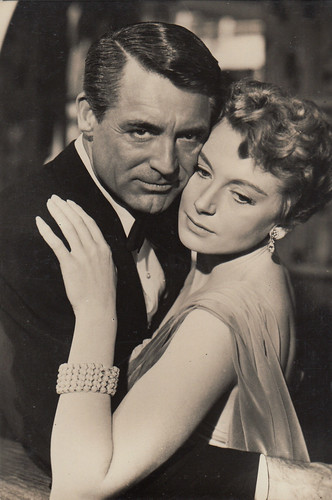
Spanish postcard by Ediciones JRB, no. 178/1. Cary Grant and Deborah Kerr in An Affair to Remember (Leo McCarey, 1957). Collection: Marlene Pilaete.
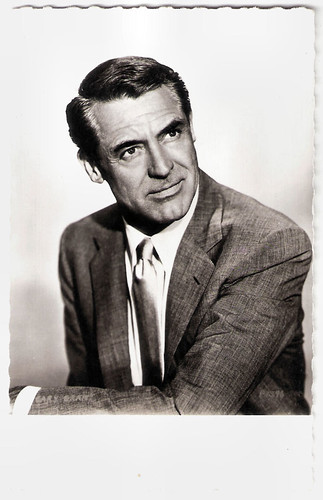
French postcard by Editions P.I., Paris, offered by Les Carbones Korès 'Carboplane', no. 999. Photo: Paramount. Publicity still for Houseboat (Melville Shavelson, 1958).
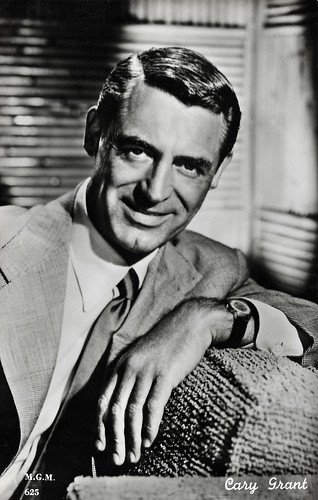
Vintage card, no. 625. Photo: M.G.M.
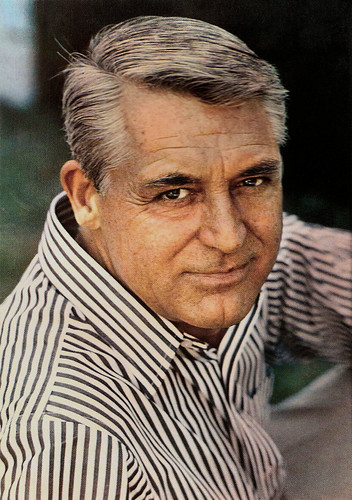
Italian postcard by Rotalfoto, no. N. 207.

Spanish postcard by Soberanas, no. 12.004. Photo: 20th Century Fox. Cary Grant in Operation Petticoat (Blake Edwards, 1959).

Dutch freecard by Boomerang, Amsterdam, for the retrospective 'Hitchcock totaal' in the Nederlands Filmuseum, Amsterdam. Photo: Cary Grant in North by Northwest (Alfred Hitchcock, 1959).

Romanian postcard by Casa Filmului Acin, no. 553. Cary Grant in 1970 receiving an Honorary Oscar from Frank Sinatra. Collection: Alina Deaconu.
Sources: Dale O'Connor (IMDb), Wikipedia and IMDb.

Belgian postcard by N.V. Victoria, Brussels, no. 639. Photo: Metro-Goldwyn-Mayer.

French postcard by EPC, no. 29. Photo: RKO.

British postcard in the Colourgraph Series, London, no. C 213. Photo: Paramount.

British postcard in the Picturegoer Series, London, no. 735A. Photo: Paramount.

British postcard in the Picturegoer Series, London, no. 735b. Photo: Paramount.

British postcard in the Picturegoer Series, London, no. 735c. Photo: Columbia.

German collectors card. Photo: RKO Radio Film. Cary Grant and Ingrid Bergman in Notorious (Alfred Hitchcock, 1946).

British postcard in the Picturegoer Series, London, no. W 609. Photo: R.K.O. Radio.

American postcard by Fotofolio. Photo: Milton H. Greene. Caption: Cary Grant, New York City, 1958.

French postcard in the Collection Noire by Editions Hazan, Paris, no. 6492, 1996. Photo: Collection Dominque Lebrun D.R. Cary Grant in North by Northwest (Alfred Hitchcock, 1959).
The combination of virility, sexuality and the aura and bearing of a gentleman
Cary Grant was born Archibald Alexander Leach in Horfield, Bristol, England, in 1904. His parents were Elsie Maria (Kingdon) and Elias James Leach, who worked in a factory. Grant considered himself to have been partly Jewish. He had an unhappy upbringing in Bristol. At age nine, he came home from school one day and was told his mother had gone off to a seaside resort. The real truth, however, was that she had been placed in a mental institution, where she would remain for years, and he was never told about it. Grant did not learn that his mother was still alive until he was 31, when his father confessed to the lie, shortly before his own death.
At age 14, Archibald dropped out of school. He lied about his age and forged his father's signature on a letter to join Bob Pender's troupe of knockabout comedians. He learned pantomime as well as acrobatics as he toured with the Pender troupe in the English provinces. Then in 1920, he was one of the eight Pender boys selected to go to the US. Their show on Broadway, 'Good Times', ran for 456 performances at the New York Hippodrome, the largest theatre in the world at the time with a capacity of 5,697. It gave Grant time to acclimatise.
Cary Grant would stay in America. He spent the next couple of years touring the United States with The Walking Stanleys. He visited Los Angeles for the first time in 1924, which left a lasting impression on him. After the group split up, he returned to New York, where he began living and performing at the National Vaudeville Artists Club. In 1927, he was cast as an Australian in Reggie Hammerstein's musical, 'Golden Dawn'.
In the following years, he gained a reputation as a romantic leading man. After a successful screen test, Paramount producer Bud Schulberg signed a contract with the 27-year-old Grant in 1931 for five years. He made his feature film debut with the comedy This is the Night (Frank Tuttle, 1932), playing an Olympic javelin thrower opposite Thelma Todd and Lily Damita.
Grant played a wealthy playboy opposite Marlene Dietrich in Blonde Venus (1932), directed by Josef von Sternberg. Mae West wanted Grant for She Done Him Wrong (Lowell Sherman, 1933) because she saw his combination of virility, sexuality and the aura and bearing of a gentleman. The film was a box office hit, earning more than $2 million in the United States. For their next pairing, I'm No Angel (Wesley Ruggles, 1934), Grant's salary was increased from $450 to $750 a week. The film was even more successful than She Done Him Wrong and saved Paramount from bankruptcy.

British Real Photo postcard. Photo: Paramount Pictures.

British Real Photograph postcard. Photo: Paramount.

British Real Photograph postcard, no. 214.

British Art Photo postcard, no. 5904 M. Photo: Paramount. Publicity still for Devil and the Deep (Marion Gehring, 1932).

German postcard by Ross Verlag, no. 6870/1, 1931-1932. Photo: Paramount. Publicity still for This is the Night (Frank Tuttle, 1932) with Lily Damita.

German postcard by Ross Verlag, no. 168/1. Photo: Paramount. Publicity still for Madame Butterfly (Marion Gering, 1932) with Sylvia Sidney.

French postcard by Editions Chantal, Paris, no. 573. Photo: Paramount.

French postcard by Editions E.C., Paris, no. 373.

Belgian card by Nels for Kwatta. Photo: R.K.O.

French postcard by A.N., Paris, no. 893. Photo: Paramount.
A leopard and frequent bickering and verbal jousting
When the Paramount contract was up, Cary Grant made an unusual decision for the time: he decided to freelance. Because his films were so successful at the box office, he was able to work at any studio he chose for the majority of his career.
For Hal Roach's studio, he made the screwball comedy Topper (Norman Z. McLeod, 1937), which became his first major comedy success. The following year, he starred opposite Katharine Hepburn in the screwball comedy Bringing Up Baby (Howard Hawks, 1938), featuring a leopard and frequent bickering and verbal jousting between Grant and Hepburn.
He played a British army sergeant opposite Douglas Fairbanks, Jr. in the adventure film Gunga Din (George Stevens, 1939), set at a military station in India, and he was a pilot opposite Jean Arthur and Rita Hayworth in the drama Only Angels Have Wings (Howard Hawks, 1939). Grant gained even more success for his appearances in the romantic comedies His Girl Friday (Howard Hawks, 1940) with Rosalind Russell, and The Philadelphia Story (George Cukor, 1940) with Katharine Hepburn and James Stewart.
Along with Arsenic and Old Lace (Frank Capra, 1944) and I Was a Male War Bride (Howard Hawks, 1949); these films are among the all-time great comedy films. Having established himself as a major Hollywood star, Cary Grant was nominated twice for the Academy Award for Best Actor, for Penny Serenade (George Stevens, 1941) and None but the Lonely Heart (Clifford Odets, 1944).
In the 1940s, Grant also started a working relationship with director Alfred Hitchcock, appearing in films such as Suspicion (1941) opposite Joan Fontaine, and Notorious (1946) opposite Ingrid Bergman. Hitchcock admired Grant and considered him to have been the only actor that he had ever loved working with. In To Catch a Thief (1955), he and Grace Kelly were allowed to improvise some of the dialogue. They knew what Hitchcock wanted to do with a scene, they rehearsed it, put in some clever double entendres that got past the censors, and then the scene was filmed. His biggest box-office success was Hitchcock’s North by Northwest (1959) made with Eva Marie Saint since Kelly was by that time Princess of Monaco.

British Real Photo postcard. Photo: Paramount Pictures.

British Art Photo postcard, no. 106. Photo: Paramount Pictures Inc. Cary Grant and Joan Bennett in Wedding Present (Richard Wallace, 1936).

French postcard in the Collection 'Portraits de Cinema' (4th series, no. 2) by Editions Admira & Chapman Collection / SNAP Photos / Cosmos, no. PHN 662, 1989. Cary Grant and Katharine Hepburn in Bringing Up Baby (Howard Hawks, 1938).

British postcard in the Greetings series. Photo: United Artists. Cary Grant in Destination Tokyo (Delmer Daves, 1943).

French postcard in the Collection 'Portraits de Cinema'(2nd series, no. 9) by Editions ADMIRA & Hollywood Photographers Archives, no. PHN 357, 1987. Photo: Paramount. Caption: Cary Grant (1945).

German collectors card. Photo: RKO Radio Film. Publicity still for Notorious (Alfred Hitchcock, 1946) with Ingrid Bergman.

French postcard. Photo: Keystone - L'Illustration. Cary Grant and Betsy Drake in Every Girl Should Be Married (Don Hartman, 1948).

Dutch postcard, no. 3286. Photo: 20th Century Fox. Publicity still for I Was a Male War Bride (Howard Hawks, 1949).

French postcard by Editions P.I., Paris, no. 287. Photo: Warner Bros.

French postcard by Editions P.I., Paris, offered by Les Carbones Korès 'Carboplane', no. 667. Photo: Paramount, 1951.
Marriages, living arrangements and fatherhood
Cary Grant was young enough to begin the new career of fatherhood. Grant retired from the screen at 62, when his daughter Jennifer was born, to focus on bringing her up and to provide a sense of permanency and stability in her life. Although Grant had stopped making films, he remained active. In 1966, he accepted a position on the board of directors at Fabergé. By all accounts this position was not honorary, as some had assumed; Grant regularly attended meetings and travelled internationally to support them. The position also permitted the use of a private plane, which Grant could use to fly to see his daughter wherever her mother, Dyan Cannon, was working.
He later joined the boards of Hollywood Park, the Academy of Magical Arts (The Magic Castle, Hollywood, California), Western Airlines (acquired by Delta Air Lines in 1987), and MGM. In 1999, the American Film Institute named Grant the second greatest male star of Golden Age Hollywood cinema after Humphrey Bogart. He was nominated twice for the Academy Award for Best Actor and five times for the Golden Globe Award for Best Actor. After he retired from film in 1966, Grant was presented with an Honorary Oscar in 1970.
He expressed no interest in making a career comeback. He was in good health until almost the end of his life, when he suffered a mild stroke in October 1984. His final appearance at the Academy Awards was in 1985 to present James Stewart with an honorary Oscar for lifetime achievement. In the last few years of his life, Grant undertook tours of the United States in a one-man show, 'A Conversation with Cary Grant', in which he would show clips from his films and answer audience questions.
In 1986, Cary Grant suffered a major stroke before performing in his one-man show in Davenport, Iowa. He died later that night at St. Luke's Hospital. Grant had been married five times. His wives were actress Virginia Cherrill (1934-1935), Barbara Hutton (1942-1945), actress Betsy Drake (1949-1962), actress Dyan Cannon (1965-1968), and Barbara Harris (1981-1986).
From 1932 to 1944 he shared a house with Randolph Scott, whom he met on Hot Saturday (William A. Seiter, 1932). Studio heads threatened not to employ them together unless they lived separately. Grant's marriage to Barbara Hutton permanently dissolved his living arrangement with Scott. Grant later fell in love with Sophia Loren while filming The Pride and the Passion (Stanley Kramer, 1957) when he was 53 and she was 22. At the time, Grant was still married to actress Betsy Drake, and Loren was involved with 45-year-old producer Carlo Ponti, who was also married. Both men eventually separated from their wives and proposed to Loren at the same time. She chose Ponti.

British postcard in the Picture Show Postcard Series.

German flyer by Illustrierte film-bühne, no. 3076, part 1. Photos: Paramount. Cary Grant in To Catch A Thief (Alfred Hitchcock, 1955).

German flyer by Illustrierte film-bühne, no. 3076, part 4. Photos: Paramount. Cary Grant and Grace Kelly in To Catch A Thief (Alfred Hitchcock, 1955).

Spanish postcard by Ediciones JRB, no. 178/1. Cary Grant and Deborah Kerr in An Affair to Remember (Leo McCarey, 1957). Collection: Marlene Pilaete.

French postcard by Editions P.I., Paris, offered by Les Carbones Korès 'Carboplane', no. 999. Photo: Paramount. Publicity still for Houseboat (Melville Shavelson, 1958).

Vintage card, no. 625. Photo: M.G.M.

Italian postcard by Rotalfoto, no. N. 207.

Spanish postcard by Soberanas, no. 12.004. Photo: 20th Century Fox. Cary Grant in Operation Petticoat (Blake Edwards, 1959).

Dutch freecard by Boomerang, Amsterdam, for the retrospective 'Hitchcock totaal' in the Nederlands Filmuseum, Amsterdam. Photo: Cary Grant in North by Northwest (Alfred Hitchcock, 1959).

Romanian postcard by Casa Filmului Acin, no. 553. Cary Grant in 1970 receiving an Honorary Oscar from Frank Sinatra. Collection: Alina Deaconu.
Sources: Dale O'Connor (IMDb), Wikipedia and IMDb.
No comments:
Post a Comment